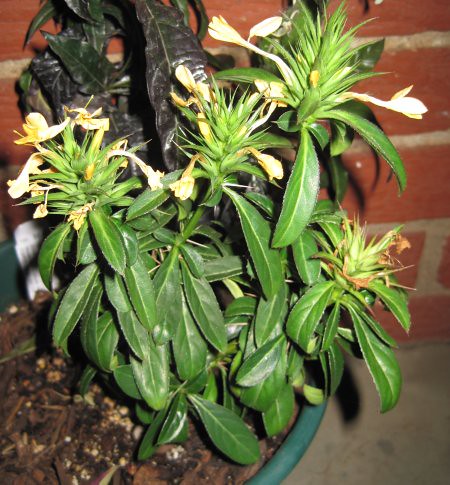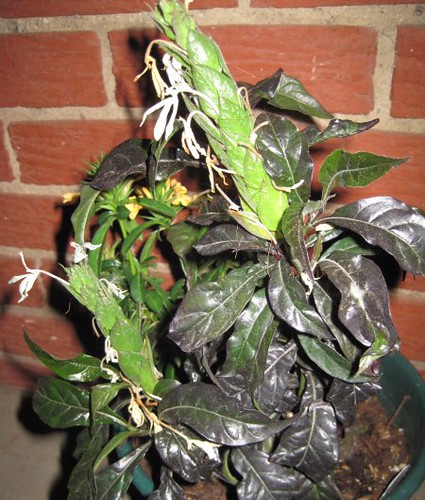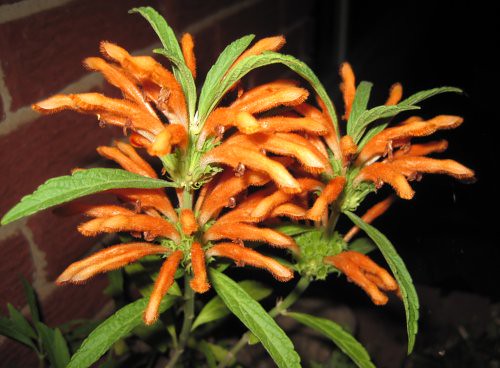This week my wife and I announced some very exciting news to all of our family and friends: We are adopting our first child from Ethiopia! We're 3 months into an 18-month process. Lots of waiting ahead.
In the meantime, we have been learning a lot about parenting, about adoptive parenting and about Ethiopian culture. As you might imagine, I couldn't pass up the chance to learn about (and purchase) some new plants. The wonderful Bustani Plant Farm, which I discovered last Spring, has a great selection of rare plants from Africa. Before going to Bustani this year, I did some research on several plants that were labeled "East African" in their catalog. I discovered that at least three different plants they had for sale grow natively in Ethiopia. Is it important that my children grow up around plants from their home country? Probably not. But I like them! :)
Barleria eranthemoides
The owners of Bustani collected this plant in coastal Kenya in 2002. It has bracts of salmon-orange blooms. The bracts look similar to my Justicia shrimp plants before the blooms emerge. The foliage is dark and very attractive. The stems are covered in spines that are quite prickly but not very noticeable to the eye. I forgot about these when I was repotting it and grabbed the plant in a way that I would not have if I had remembered about the spines.
Ecbolium viride
This plant was also collected in coastal Kenya in 2002 and has blooming bracts that look similar to my Justicia shrimp plants. Indeed, both of these plants are in the same family (Acanthaceae). The blooms of these plants have the most awesome color. I tried to photograph them at Bustani and just got frustrated because they came out white! They are a really cool teal that glows. It is the same color as the Jade vine (Strongylodon macrobotrys), if you've ever seen one of those in bloom. If you haven't, finish reading this blog post and then go and do a google search on "Jade vine." The blooms of this plant have the same teal color.
Leonotis leonurus, commonly called Lion's Ears or Lion's Tail
This is really the only plant with a common name, since the others aren't grown very often in the horticultural world. [I mean, it's the only one that has a real common name. I don't consider Green Ecbolium to really be different from Ecbolium viride.] It's not surprising that this plant has been used in gardens for some time. The blooms are very unique, bright orange and fuzzy. Apparently this plant has some medicinal and "recreational" properties and is used for treating a variety of ailments in southern Africa. What I mean by "recreational" is that wikipedia says some people smoke the leaves when there's not any marijuana around. It is also found in California, Hawaii and Australia - though I don't believe it is native to all of those places.
These three plants will all have to be moved into the greenhouse over the winter, as they are only hardy to zones 9 and 10.
What do you think of my little Ethiopian collection?
In the meantime, we have been learning a lot about parenting, about adoptive parenting and about Ethiopian culture. As you might imagine, I couldn't pass up the chance to learn about (and purchase) some new plants. The wonderful Bustani Plant Farm, which I discovered last Spring, has a great selection of rare plants from Africa. Before going to Bustani this year, I did some research on several plants that were labeled "East African" in their catalog. I discovered that at least three different plants they had for sale grow natively in Ethiopia. Is it important that my children grow up around plants from their home country? Probably not. But I like them! :)
Barleria eranthemoides
 |
| Barleria eranthemoides |
Ecbolium viride
 |
| Ecbolium viride |
Leonotis leonurus, commonly called Lion's Ears or Lion's Tail
 |
| Leonotis leonurus |
These three plants will all have to be moved into the greenhouse over the winter, as they are only hardy to zones 9 and 10.
What do you think of my little Ethiopian collection?
The last plant pictured is my favorite, even though it has an "orange" flower. ;-) I am quite curious if the first pictured plant is sometimes referred to as the "crown of thorns" as it favors a couple of crown of thorn plants that I have.
ReplyDeleteRegardless, it is such fun that you are embracing plants from Ethiopia just as you will embrace your new little one whom I am sure will prize his/her dad's love of plants, and life in general. :-)